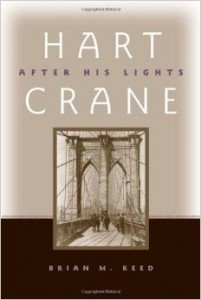 Hart Crane: After His Lights
Hart Crane: After His Lights
by Brian M. Reed
University of Alabama Press. 312 pages, $35.
THE PROJECT of Brian M. Reed’s study of Hart Crane is two-fold: he seeks not only to examine and illuminate the poetry of Hart Crane, but to endorse and revive the practice of literary criticism focused on a single author. Crane’s body of work was spare—he published only two collections of poetry before taking his own life at the age of 32—but by the time of his death his poems had earned the admiration of Allen Tate and Edmund Wilson, among others; and his reputation and influence have only grown in the decades since his death. Reed wants to give Crane his due, and his study is one of the most complete examinations of Crane’s work in more than a decade.
Crane is perhaps best known for his long poem of 1930, “The Bridge,” a meditative, expansive work inspired by the Brooklyn Bridge, images of which tend to adorn the covers of editions of his work, as well as the cover of Reed’s book. It is difficult to imagine a poet at work today capturing the American imagination with a single work the way Crane did with this poem. In providing an explication of Crane’s writing, and his influence, Reed seeks to combat the general tendency to place Crane into easy categories, and Crane’s sexuality is perhaps the easiest of them all.
Reed certainly factors Crane’s homosexuality into his analysis of the writer’s work, but he also provides a thorough exploration of Crane’s relationship with his contemporaries along with close readings of their work. As a poet, Crane was very much a man out of step with his times. Although Pound and the imagists ruled the day, Reed notes that Crane was more closely aligned, stylistically, with earlier British poets such as Gerard Manley Hopkins and Algernon Charles Swinburne. He was also heavily influenced by the themes of “Sapphic modernism” as exemplified by Gertrude Stein and Djuna Barnes. Crane and Barnes were both dissenters from the Pound school and knew each other briefly. Reed devotes considerable space to Barnes by way of an extended comparison between her and Crane, all part of an attempt to grasp Crane’s relationship to his sexuality. For Reed, Crane’s writing was not as stridently queer in its subject matter as that of Barnes and the Sapphic modernists, but he was deviant, even decadent, in terms of his formal æsthetics.
Reed offers a detailed analysis of Crane’s “wasteful” poetics, and makes much of Crane’s habit of writing to the accompaniment of his Victrola, which he would play loudly and repeatedly while writing, usually late at night, much to the annoyance of his neighbors. (Maurice Ravel’s Bolero was a favorite, and Reed devotes considerable attention to Crane’s relationship to that piece of music.) The last third of Reed’s study examines Crane’s legacy and focuses on three late-20th-century poets, Paul Blackburn, Frank O’Hara, and Bob Kaufman, all of whom were indebted to Hart Crane.
Reed has a solid grounding in recent and contemporary literary criticism, and he makes good use of that context in presenting his re-evaluation of Crane’s contribution. A large portion of his study is devoted to a close analysis of Crane and his contemporaries. For whatever reason, he sees fit to digress into apologies for poetry itself: “Verse provides an inestimable counterweight to the deadening generalities of bureaucratic thinking, mediaspeak, and academic jargonfests.” Reed has taken on quite an ambitious project, but he does an admirable job of depicting Crane as an important figure who provided the bridge between the prophetic, operatic tradition of the British poets he admired and the late-20th-century avant-garde that he helped inspire.
____________________________________________________________________
Jim Nawrocki, a writer based in San Francisco, is a frequent contributor to this journal.





